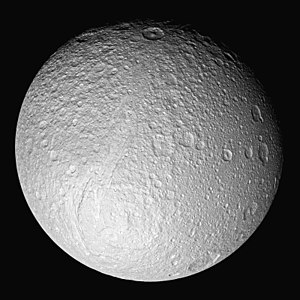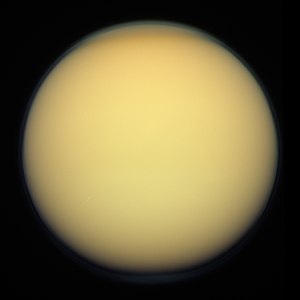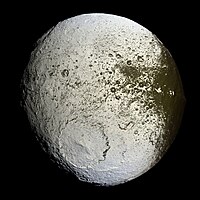The Moons of Saturn
The content of this page is outdated If you have checked or updated this page and found the content to be suitable, please remove this notice. |

Sixty-two of these, 53 with official names. Technically the rings could be considered conglomerations of millions of moons, but there's only so much space on the Internet. They were originally all named after Titans of the Greek myths, but so many have been discovered that the outer "irregular" moons have been divided into the "Gallic", "Norse" and "Inuit" groups after the sources of their names.
The Ringmasters: Pan, Daphnis, Atlas, Prometheus, etc.
Small moons that orbit near (or sometimes between) Saturn's various rings. They're also known as "shepherd moons" because they keep the particles that make the rings up in line. These moons are only a few kilometers in diameter, as this close to Saturn (i.e. within the Roche Limit) anything larger would get slowly torn apart. Voyager and Cassini have taken pictures of the various kinks, twists and waves inflicted on the rings by their gravitational wakes.
That's No Space Station: Mimas

A small moon that got hit by a big rock at some point and just barely avoiding breaking up. This had led the moon to resemble the Death Star, with a 130-km crater named Herschel that almost exactly corresponds to the fictional space station's laser dish[1]. Mimas is also slightly egg-shaped, with the long end pointed toward Saturn. Bizarrely, a temperature map produced by NASA showed that the warmer regions of the moon looks like Pac-Man.
Its surface features (apart from Herschel) are named after people and places from the legend of King Arthur (Avalon Chasma, the crater Galahad, etc.)
Europa Too: Enceladus

Just like the Jovian moon, Enceladus is suspected to hide an ocean of liquid water underneath its surface, due to water vapour eruptions from Enceladus' many cryovolcanic vents. Cassini flew through and found evidence of complex organic molecules - a possible marker for life. By virtue of being covered with ice it is the most reflective object in the Solar System. Enceladus is smaller than Europa and has almost none surface gravity, that's why streams of water and steam bursting from cracks in the ice become long, impressive plumes.
Its surface features are named after people and places from the stories of the Arabian Nights (Baghdad Sulcus, the crater Sindbad, etc.)
To ensure maximum verisimilitude when writing stories set on Enceladus, consult the 2008 map set available from NASA.
Ithaca Is Gorges: Tethys

A mid-size moon marked by a very long (2000km), very wide (100km) and very deep (3-5km) canyon system, the Ithaca Chasma. Some scientists theorized that Tethys used to have subsurface liquid water before it all froze solid, causing the surface to "crack".
Like Mimas, Tethys also has a very big crater called Odysseus, which is 400 km in diameter (or approximately 2/5 of Tethys'). It is much shallower than Mimas' Herschel though. Two smaller, irregular, "Trojan" moons, Telesto and Calypso, also share the same orbit around Saturn as Tethys.
Its surface features are named after people and places from The Odyssey (the aforementioned Ithaca Chasma, the crater Telemachus, etc.)
A Cracking Good Time: Dione

Another mid-size moon with surface features (cracks, troughs, smooth plains, rises and depressions) which seems to indicate past or present tectonic or volcanic activities. Pictures from the Voyager probes showed wispy white lines that were thought to be frost; Cassini proved them to be cliffs hundreds of meters high. Like Tethys, it also has orbit-mates, or Trojan Moons - Helene and Polydeuces are irregular lumps of rock.
Its surface features are named after people and places from The Aeneid (Carthage Fossae, the crater Aeneas, etc.)
I Want To Be Just Like Mommy: Rhea

The second largest Saturnian moon. The most interesting surface feature of this otherwise heavily-cratered moon is... a large crater, called Tirawa, with bright rays radiating outwards. Perhaps to compensate for general boringness Rhea, like Saturn, has a ring system (the only moon in the Solar System which does). The rings, however, are very dark and very tenuous.
Its surface features are named after elements from non-European creation myths (the craters Izanagi and Izanami, Kunlun Linea, etc.)
Rhea has a thin atmosphere [dead link]. (And by "thin," we mean "more rarefied than a laboratory vacuum.")
The Big One: Titan

The second biggest moon in the Solar System (after Jupiter's Ganymede) and comprising 96% of all mass in orbit around Saturn. Despite its size (larger than Mercury), it only has one-seventh the Earth's gravity and its bulk density is less than twice that of water - there's a lot of ice and rock mixed in.
It's covered in a thick hydrocarbon haze, making it only moon to have a full-blown atmosphere. It's also the only known celestial body in the Solar System, apart from Earth, to have both a solid surface and basins of liquid on it. Unlike Earth's oceans, the liquids in question are light hydrocarbons, mostly methane and ethane -- basically the same stuff that the atmosphere is made of.
Due to its uniqueness, Titan occasionally appears in fiction.
Cassini carried an atmospheric entry probe, Huygens (built and managed by the European Space Agency and named after the discoverer of this moon), along on its trip to the system. On its way there the mission control team realized the Doppler shift caused by the differing velocities of Cassini and Huygens would cause its radio signals to become unreadable. They changed Huygens' approach vector to reduce the shift, and the data and pictures were successfully transmitted as the probe parachuted in over Xanadu Terra. Unfortunately, half of them were never picked up because a programming error prevented Cassini from listening to one of the two data channels; nevertheless the pictures revealed a strangely Earth-like landscape of what looked like drainage channels, islands and seas (all produced by hydrocarbons). Pictures from the surface showed a gloomy, orange-tinted plain covered with "ice pebbles".
The lakes, craters and drainage channels on Titan are named after lakes and rivers from earth (e.g. Ontario Lacus), while other features are named after sacred and enchanted places on Earth and deities of peace, happiness, beauty and wisdom (Shangri-La, Ganesa Macula, etc.). Interestingly, Titanian planitia (low plains) are named after planets from Frank Herbert's Dune; so far they've done only two (Arrakis and Chusuk).
Spongebob Not-So-Square-Moon: Hyperion

A small irregular moon (smaller than Mimas) shaped and colored like a sponge. Hyperion is notable for being the only moon in the solar system to have a "chaotic rotation", meaning it lacks poles (no, not the Central European kind)[2] or a stable axis of rotation. This essentially makes Hyperion's orientation in space unpredictable. A very hyperactive moon, indeed.
Its surface features are named after sun and moon deities (e.g. the crater Helios).
Yin and Yang: Iapetus

Famously very white on its trailing side and very black (i.e. as dark as coal) on its leading side, Iapetus was discovered by Giovanni Cassini in 1671. The moon is tidally locked. Its two-tone nature was a mystery until 2009, when the Spitzer Space Telescope discovered a very dim ring of dust generated by the outer moon Phoebe. Since Phoebe orbits Saturn in the opposite direction, as the "Phoebe ring" spreads out it smacks into Iapetus head-on and darkens that side. Cassini also discovered a gigantic equatorial ridge that some people have compared to plastic sprue or the surface of a walnut.
Its surface features are named after people and places from The Song of Roland (Roncevaux Terra, the crater Ganelon, etc.)
The intended destination of the mission in the book 2001: A Space Odyssey.
Odd Girl Out: Phoebe

Phoebe was the first moon to be discovered photographically (in 1898) and was the outermost of Saturn's known moons until more were discovered in the 2000s (it's now considered a member of the "Norse group" of irregular satellites). Its main claim to fame was its retrograde orbit and very low albedo, and it was long thought to be a captured asteroid. Recent evidence points to it being a captured "centaur" (a Kuiper belt object pulled in from its normal stomping grounds out by Pluto by the permutations of the gas giants).
Its surface features are named after people and places from the myth of Jason and the Argonauts (e.g. the crater Hylas).
Goddess of Memory: Mnemosyne
The fictional outermost moon in Arthur C. Clarke's Imperial Earth. It has almost no spin and is far from the Sun's electromagnetic field, making it ideal for the CETI radio 'Argus'. Though it was referred to as the 22nd moon, many more satellites were discovered since the book was written.
- ↑ The Voyager probes discovered the crater three years after A New Hope was released, so whatever the faults of George Lucas are, plagiarism isn't one of them. At least this time.
- ↑ All right, technically it lacks both poles and Poles... at least, it does until somebody from Poland actually visits Hyperion.